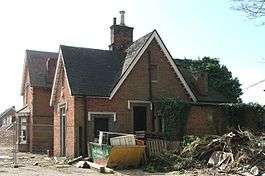Buntingford Branch Line

Buntingford Branch Line | ||||||||||||||||||||||||||||||||||||||||||||||||||||||||||||||||||||||||||||||||||||||||||
|---|---|---|---|---|---|---|---|---|---|---|---|---|---|---|---|---|---|---|---|---|---|---|---|---|---|---|---|---|---|---|---|---|---|---|---|---|---|---|---|---|---|---|---|---|---|---|---|---|---|---|---|---|---|---|---|---|---|---|---|---|---|---|---|---|---|---|---|---|---|---|---|---|---|---|---|---|---|---|---|---|---|---|---|---|---|---|---|---|---|---|
Legend
| ||||||||||||||||||||||||||||||||||||||||||||||||||||||||||||||||||||||||||||||||||||||||||
The Buntingford Branch Line or The Bunt[1] was a railway in Hertfordshire in the United Kingdom. It ran between the village of St Margarets and the town of Buntingford. It branched off what is now known as the Hertford East Branch Line.
History
After a bill for a new route from Ware to Cambridge via Buntingford failed to gain approval in parliament, the feasibility of a branch line was discussed at a couple of town meetings in 1856, and in 1857 the Ware, Hadham and Buntingford Railway was formed,[2] with Henry Palfrey Stephenson serving as engineer.[3] In 1858, the route gained authorisation from government. As the name suggests, the original intention was for the line to serve the town of Ware, but that was changed to St Margarets, a stop closer to London.[2][4] The change was due to a dispute with a local landowner.[2]
With the help of the Eastern Counties Railway (which merged into the Great Eastern Railway in 1862), the route gained enough capital, after initially struggling due to other landowner disputes, the need to cross the River Rib and the River Ash, and some problems with design. The railway opened 3 July 1863.[2][4][5] After a brief separate existence, the company was merged in 1868 with its parent the Great Eastern, which had run the line from the start.[4]
Although rural, the line was fairly well used by passengers, particularly after through trains to London were established.[4] Cheap tickets were offered on Sundays to encourage walkers to use the line.[2] There was also freight traffic of three trains a day, which was mainly agricultural, although there was also a rail-served flour mill at Standon.[2][4] The line was dieselised in 1959 but the through trains were cut and it is thought that this, combined with the increased use of cars to get access to faster competing rail routes, led to the line's decline for the next five years. After 101 years of services, the line closed to passengers in 1964, as recommended in the Beeching report.[2][4][5] Freight traffic on the line ceased in 1965.[4]
Route
The railway ran on a north-south axis from Buntingford to just north of St Margarets near Hoddesdon, Hertfordshire. It served an area of the countryside which had hardly any industry. The route from start to finish was approximately 13.8 miles (22.2 km) long. The route was noted for its numerous bridges and steep grades.[4]
All stations opened after St Margaret's opened in 1863 and closed in 1964. The line had passing loops at Braughing and Hadham. It should also be noted that Mardock had the suffix "for Wareside".[4]
Places served were Wareside, Widford, Much Hadham, Standon, Braughing, Westmill and Buntingford.
Buntingford Station

Buntingford served as the terminus of the Hertford East Branch Line. It was opened 3 July 1863 and closed to passengers just over a century later 16 November 1964.[6] It was served by direct trains from London Liverpool Street until around 1960.
Modern usage
Parts of the trackbed have been used as parts of the footpath network.[5] Buntingford Station is currently being redeveloped into housing, the line itself is only visible in one small area of wasteland outside Buntingford
References
- ↑ "The Bunt". Buntingford Railway and Local History Society. Retrieved 19 June 2014.
- 1 2 3 4 5 6 7 "Buntingford Station". Subterranea Britannica. 2008-04-15.
- ↑ Obituary: Henry Palfrey Stephenson (1826-1890), ICE, 1890. Retrieved: 30 September 2015.
- 1 2 3 4 5 6 7 8 9 Scholey, Keith (2003). Hertfordshire's Lost Railway. Stenlake Publishing. ISBN 1-84033-231-X.
- 1 2 3 Charles, Alan (1998). Pub Walks in Hertfordshire: Thirty Circular Walks Around Hertfordshire Inns. Countryside Books. ISBN 1-85306-294-4.
- ↑ Buntingford station at Subterranea Britannica